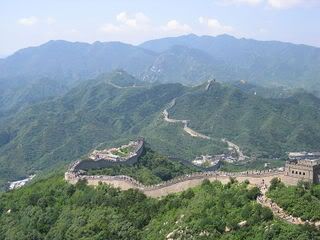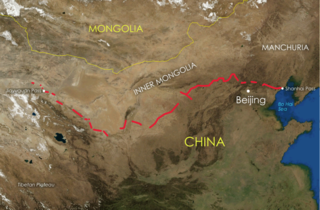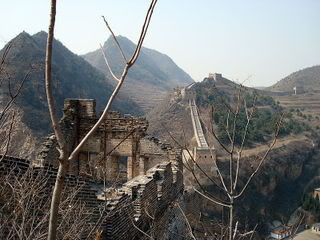Assalamualaikum and Peace be upon all of you..
Thanks for viewing my blog.
Thanks for viewing my blog.
The Great Wall of China is a series of stone and earthen fortifications in China, built, rebuilt, and maintained between the 5th century BC and the 16th century to protect the northern borders of the Chinese Empire from Xiongnu attacks during the rule of successive dynasties. Several walls, referred to as the Great Wall of China, were built since the 5th century BC. One of the most famous is the wall built between 220–206 BC by the first Emperor of China, Qin Shi Huang; little of it remains; it was much farther north than the current wall, which was built during the Ming Dynasty.
The Great Wall stretches over approximately 6,400 km (4,000 miles) from Shanhaiguan in the east to Lop Nur in the west, along an arc that roughly delineates the southern edge of Inner Mongolia, but stretches to over 6,700 km (4,160 miles) in total. At its peak, the Ming Wall was guarded by more than one million men. It has been estimated that somewhere in the range of 2 to 3 million Chinese died as part of the centuries-long project of building the wall.
HISTORY
No exact record about when the first constructions of the Great Wall, but it is believe starting from the 5th - 220th BC. At that time, the chinese has already familiar with the wall-building techniques.
Qin Dynasties:
After Qin Shi Huang unified China in 220BC and established a new Qin Dynasties, he ordered building a new wall along the empire's northern frontier to protect the empires from the attack of Hiongnu people from the north.
Transporting the large quantity of materials required for construction was difficult, so builders always tried to use local resources. Stones from the mountains were used over mountain ranges, while rammed earth was used for construction in the plains.
Later, the Han, Sui, Northern and Jin dynasties all repaired, rebuilt, or expanded sections of the Great Wall at great cost to defend themselves against northern invaders.
There are no surviving historical records indicating the exact length and course of the Qin Dynasty walls.
Ming Dynasties:
Lost in the Battle of Tumu in 1449, the Ming Dynasty has ordered to build the wall to keep the nomadic tribes in the north out of the empires.
Unlike the Qin, the Ming construction was stronger and more elaborate due to the use of bricks and stone instead of rammed earth. As Mongol raids continued periodically over the years, the Ming devoted considerable resources to repair and reinforce the walls. Sections near the Ming capital of Beijing were especially strong.
Towards the end of the Ming Dynasty, the Great Wall helped defend the empire against the Manchu invasions that began around 1600. Under the military command of Yuan Chonghuan, the Ming army held off the Manchus at the heavily fortified Shanhaiguan pass, preventing the Manchus from entering the Chinese heartland. The Manchus were finally able to cross the Great Wall in 1644, when the gates at Shanhaiguan were opened by Wu Sangui, a Ming border general who disliked the activities of rulers of the Shun Dynasty. The Manchus quickly seized Beijing, and defeated the newly founded Shun Dynasty and remaining Ming resistance, to establish the Qing Dynasty.
During the Qing Dynasty, constructions and repair of the Great Wall were discontinued.
CONDITION
Parts of the wall near Beijing and near Tourist attractions has been preserved, even reconstructed. But most of the locations of the Great Wall is in disrepair. Some parts even serve as the village playground, source of stones for rebuild house and roads, prone to graffiti and vandalism, some parts have been destroyed because the Wall is in the way of construction.
No comprehensive survey of the wall has been carried out, so it is not possible to say how much of it survives, especially in remote areas. More than 60 kilometres (37 mi) of the wall in Gansu province may disappear in the next 20 years, due to erosion from sandstorms. In places, the height of the wall has been reduced from more than five meters (16.4 ft) to less than two meters. The square lookout towers that characterize the most famous images of the wall have disappeared completely. Many western sections of the wall are constructed from mud, rather than brick and stone, and thus are more susceptible to erosion.
URBAN LEGEND
Many popular belief said that the Great Wall of China is;
"the mightiest work of man, the only one that would be visible to the human eye from the moon,"
But, according to the anecdotal reports by Ed Lu, Expedition 7 Science Officer aboard the International Space Station, adds that;
"it's less visible than a lot of other objects. And you have to know where to look."
Thus, no other man made object could possibly been seen by naked eyes from the moon.
GALERIA
Some of the scenery of the Great Wall.
GALERIA
Some of the scenery of the Great Wall.
CONCLUSION
It is a suprised that the Chinese civilization actually have the technology to build the wall since the 5th century. The Great Wall has done its job protecting the Empire from the outsiders. Yet, the Empires still fall not because of the failure of the Wall, but from the corruption of the Empire itself.
Currently, the wall has been list among the 7 new wonder of the world and Unesco Heritage Sites.
At last, it is proved that no man-made object can be seen at the moon.
 RSS Feed
RSS Feed Twitter
Twitter



















0 comments:
Post a Comment